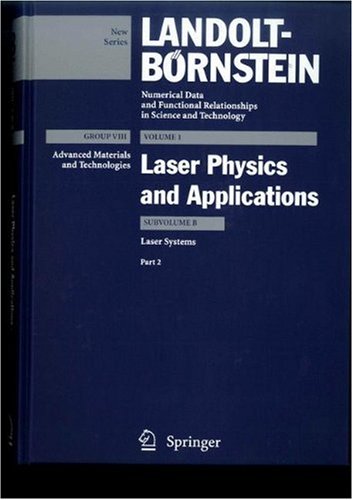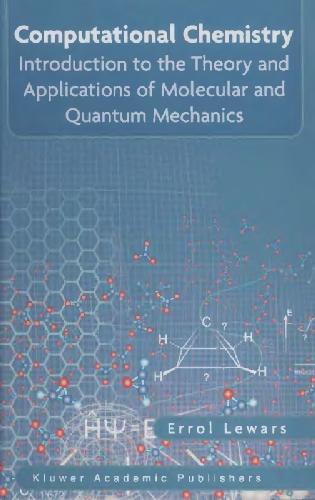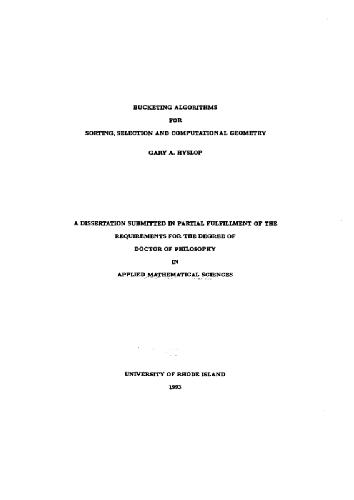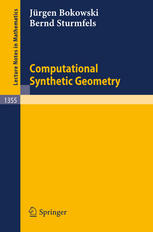Wolfgang Schulz, Rene Beigang, Adlin Bruns, Erich Gornik, Hans Jürgen Hoffmann, Reinhard Iffländer, Karol Adam Janulewicz, Michael J. Kelley, Jens Limpert, George R. Neil, Peter V. Nickles, W. Sandner, Andreas Tünnermann, Hans Wenzel3540443800, 9783540443803
In the recent decades the laser source matured to an universal tool common to scientific research as well as to industrial use. Today the main technical goal is the generation of optical power towards shorter wavelengths, shorter pulses, higher efficiency and higher power for applications in science and industry. Tailoring the optical energy in wavelength, space and time is a requirement for the investigation of laser-induced processes, i.e. excitation, non-linear amplification, storage of optical energy, etc. According to the actual trends in laser research and development, Vol. VIII/1 is split into three parts: Vol. VIII/1A with its two subvolumes 1A1 and 1A2 covers laser fundamentals, Vol. VIII/1B with its three subvolumes 1B1, 1B2 and 1B3 deals with laser systems and Vol. VIII/1C gives an overview on laser applications.
Table of contents :
41fJyn4AsTL……Page 1
Title Pages……Page 2
7.1 X-ray lasers……Page 0
Contributors……Page 4
Preface……Page 6
Contents……Page 8
4.1.1.2 Energy-level diagram and rate equations……Page 15
4.1.1.2.1 Rate equations for a 4-level system……Page 16
4.1.1.3 Amplifiers……Page 17
4.1.1.3.2 Stationary case (or T >> tau) and J >= J_s……Page 18
4.1.1.3.3 Pulse operation for short pulses (T > P_{th}……Page 26
4.1.1.6.3 Relaxation oscillation……Page 27
4.1.1.7 Q-switch operation……Page 28
4.1.1.7.1 Single Q-switch pulse……Page 29
4.1.1.7.2 Periodical Q-switch for high pulse repetition rate (r tau >> 1)……Page 31
4.1.1.8 The 3-level system……Page 33
4.1.1.8.1 Stationary case with dN/dt = 0 and dJ/dt = 0……Page 34
4.1.1.9 Efficiency and optimization……Page 36
4.1.1.10.1 Eigenvalues for TEM-00 mode……Page 38
4.1.1.10.2 Introducing a virtual reference plane……Page 40
4.1.1.11 Thermal effects……Page 41
4.1.1.11.1 Steady-state temperature profile……Page 42
4.1.1.11.2 Thermal load……Page 43
4.1.1.11.3 Thermal lensing……Page 45
4.1.1.11.4 Experimental determination of the refracting power……Page 46
4.1.1.12.2 Two external mirrors and two rods……Page 47
4.1.1.12.3 Multiple cavities with flat mirrors……Page 48
4.1.1.12.4 Thermally invariant resonators……Page 49
4.1.1.13.1.1 Longitudinally pumped rod……Page 50
4.1.1.13.1.2 Transversally pumped rod……Page 51
4.1.1.13.3.1 Longitudinally pumped fiber……Page 52
4.1.1.13.4 Slab……Page 53
4.1.1.13.5 Diode-pumped solid-state lasers in research and development……Page 54
4.1.1.14 Solid-state laser products……Page 55
4.1.2.1.1 Laser data……Page 57
4.1.2.1.2 Optical properties……Page 58
4.1.2.1.3 Thermal parameters……Page 60
4.1.2.1.5 Crystal properties……Page 61
4.1.2.1.6 Derived data……Page 64
4.1.2.1.8 Measured values……Page 65
4.1.2.2.1 Overview……Page 66
4.1.2.2.2.1 Chromium……Page 67
4.1.2.2.2.2 Erbium Er^{3+}……Page 69
4.1.2.2.2.3 Holmium Ho^{3+}……Page 71
4.1.2.2.2.4 Neodymium Nd^{3+}……Page 72
4.1.2.2.2.5 Praseodymium Pr^{3+}……Page 75
4.1.2.2.2.7 Thulium……Page 77
4.1.2.2.2.8 Ytterbium……Page 79
4.1.3.1 Alexandrite……Page 81
4.1.3.3 Emerald……Page 82
4.1.3.4 GGG (gallium gadolinium garnet)……Page 83
4.1.3.5 GSAG (gadolinium scandium aluminum garnet)……Page 84
4.1.3.6 GSGG (gadolinium scandium gallium garnet)……Page 85
4.1.3.7 GVO(4) (gadolinium (ortho)vanadate)……Page 86
4.1.3.9 LICAF (lithium calcium aluminum fluoride)……Page 87
4.1.3.10 LNA (lanthanum neodymium hexa-aluminate), LMA (lanthanum magnesium hexa-aluminate)……Page 88
4.1.3.12 NYAB (neodymium yttrium aluminum borate)……Page 89
4.1.3.13 Quartz……Page 90
4.1.3.14 Sapphire……Page 91
4.1.3.15 YAG (yttrium aluminum garnet)……Page 92
4.1.3.16 YAP (yttrium aluminum perovskite), YALO (yttrium aluminum oxide)……Page 94
4.1.3.17 YLF (yttrium lithium fluoride)……Page 95
4.1.3.19 YSAG (yttrium scandium aluminum garnet)……Page 96
4.1.3.20 YSGG (yttrium scandium gallium garnet)……Page 97
4.1.3.21 YVO(4) (yttrium (ortho)vanadate)……Page 98
References for 4.1……Page 99
4.2.1.1 Basic considerations……Page 109
4.2.1.2 Lanthanides as active ions……Page 110
4.2.1.3 Glasses doped with Nd^{3+}……Page 112
4.2.1.4 Radiative lifetime and concentration quenching……Page 114
4.2.2.1 Thermal load of cylindrical rods……Page 115
4.2.2.2 Thermal lensing……Page 116
4.2.2.3 Increasing the maximum laser power……Page 117
4.2.3.2 Refractive index……Page 119
4.2.3.3 The refractive index as a function of the temperature……Page 120
4.2.3.5 Nonlinear effects……Page 122
4.2.4.1 Meaning of the symbols……Page 125
4.2.4.2 Manufacturer: Schott Glass Technologies……Page 126
4.2.4.3 Manufacturer: Hoya Optics……Page 128
4.2.4.4 Manufacturer: Kigre……Page 130
References for 4.2……Page 132
4.3.2 Historical background of fiber lasers……Page 136
4.3.3 Basic principles of a fiber laser……Page 137
4.3.4 Fundamentals of fiber optics……Page 138
4.3.5 Double-clad fiber lasers……Page 139
4.3.6 Ytterbium-doped fiber lasers……Page 141
4.3.7 Fiber lasers versus bulk lasers……Page 142
4.3.8 Nonlinearity — the main performance limitation of a fiber laser……Page 143
4.3.9 Photonic crystal structures in a fiber laser……Page 145
4.3.10 Power scaling consideration for cw fiber lasers……Page 148
References for 4.3……Page 149
4.4.2.1 Classification of color centers……Page 151
4.4.2.2 Preparation of laser-active color centers……Page 152
4.4.3 Laser systems……Page 153
4.4.3.1 Continuous-wave laser systems……Page 154
4.4.3.2 Pulsed laser systems……Page 155
References for 4.4……Page 156
5.1.2 Basic diode laser operational principles……Page 158
5.1.2.1 Gain in semiconductors……Page 159
5.1.2.2 Round-trip condition……Page 160
5.1.2.3 Rate equations……Page 161
5.1.2.4 Threshold behavior and optical output……Page 162
5.1.3 Lateral light/current confinement……Page 163
5.1.3.1 Longitudinal mode control — single-mode lasers……Page 164
5.1.4 Laser modulation……Page 165
5.1.4.2 Small-signal amplitude modulation……Page 166
5.1.5 Line width……Page 167
References for 5.1……Page 168
5.2.1 Introduction……Page 169
5.2.2.1 Material properties……Page 170
5.2.2.3 Doping……Page 171
5.2.2.5 Waveguide and cladding layers……Page 172
5.2.2.9 Results……Page 173
5.2.3.1 Material properties……Page 174
5.2.3.5 Waveguide and cladding layers……Page 175
5.2.3.6 Contact layer……Page 176
5.2.3.9 Results……Page 177
5.2.4 Diode lasers based on I-III-IV_2 compounds……Page 178
5.2.5.2 Substrate……Page 179
5.2.5.4 Active region……Page 180
5.2.5.5 Waveguide and cladding layers……Page 181
5.2.5.9 Results……Page 182
References for 5.2……Page 185
6.1.1 Overview……Page 190
6.1.2.1 Injector……Page 191
6.1.2.2 Accelerator……Page 192
6.1.2.3 Wiggler……Page 193
6.1.2.3.1 Processes in the wiggler……Page 194
6.1.3 Output……Page 196
6.1.4 Summary and outlook……Page 198
References for 6.1……Page 201
7.1.1 Introduction……Page 203
7.1.2.1.1 Pump energy absorption……Page 205
7.1.2.1.2 Population inversion and gain……Page 206
7.1.2.1.3 Pump power requirements for soft X-ray lasers in plasmas……Page 207
7.1.2.1.4 Kinetics of the active medium — working regimes……Page 208
7.1.2.1.4.2 Quasi-steady-state approximation……Page 209
7.1.2.1.5 Medium size and output geometry — refraction……Page 210
7.1.2.1.5.1 Refraction……Page 211
7.1.2.2.1.1 Ne-like scheme……Page 213
7.1.2.2.1.2 Ni-like schemes……Page 214
7.1.2.2.2 Recombination X-ray lasers……Page 216
7.1.2.2.3 Inner-shell photoionization (ISPI)……Page 217
7.1.2.2.4 Photoresonant pumping……Page 218
7.1.2.2.5.1 Charge-transfer schemes……Page 219
7.1.3.1 Output intensity……Page 220
7.1.3.3 Saturation……Page 221
7.1.3.4 Wavelength……Page 222
7.1.3.7 Coherence……Page 223
7.1.3.7.2 Longitudinal (temporal) coherence……Page 224
7.1.4.1.2 Low-energy prepulse pumping……Page 225
7.1.4.1.4 Transient excitation scheme……Page 226
7.1.4.1.4.2 Grazing incidence pumping (GRIP)……Page 228
7.1.4.1.4.3 XUV master oscillator–power amplifier (XMOPA)……Page 229
7.1.4.1.5 Fast capillary discharge……Page 230
7.1.4.1.6 Hybrid X-ray lasers……Page 231
7.1.4.1.7 Dense gases……Page 232
7.1.4.2 Recombination-pumped X-ray lasers……Page 233
7.1.4.3.2 Propagation issues of OFI……Page 242
7.1.4.3.3 OFI with linearly polarized pumping pulse……Page 245
7.1.4.3.4 OFI with circularly polarized pumping pulse……Page 246
7.1.4.4 Inner-shell photoionization X-ray lasers……Page 247
7.1.5.1 Diagnostics with X-ray lasers……Page 250
7.1.5.2 Interferometry……Page 253
7.1.5.4 Excitation of nonlinear processes……Page 254
7.1.6 Conclusion……Page 255
References for 7.1……Page 256
Subject Index of LB VIII/1B2……Page 264







Reviews
There are no reviews yet.